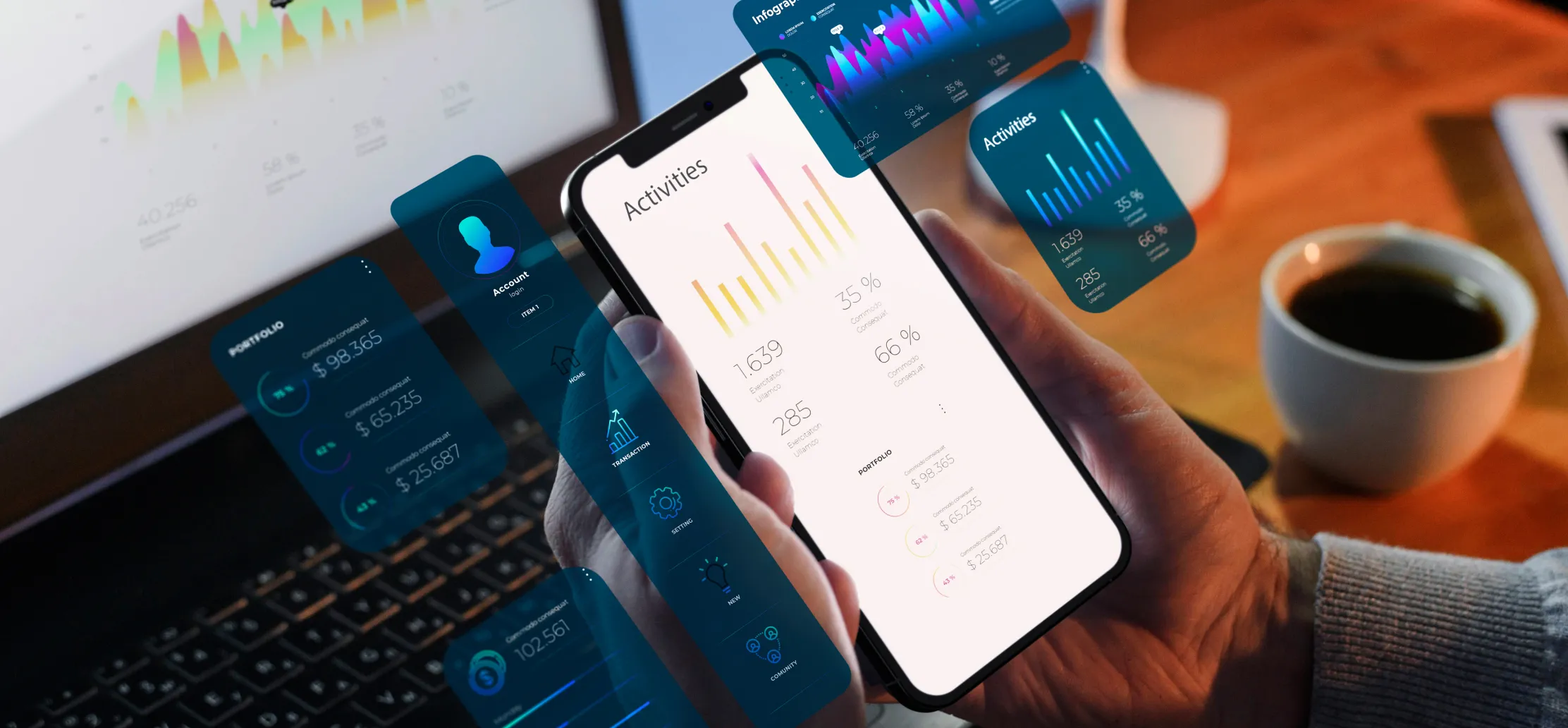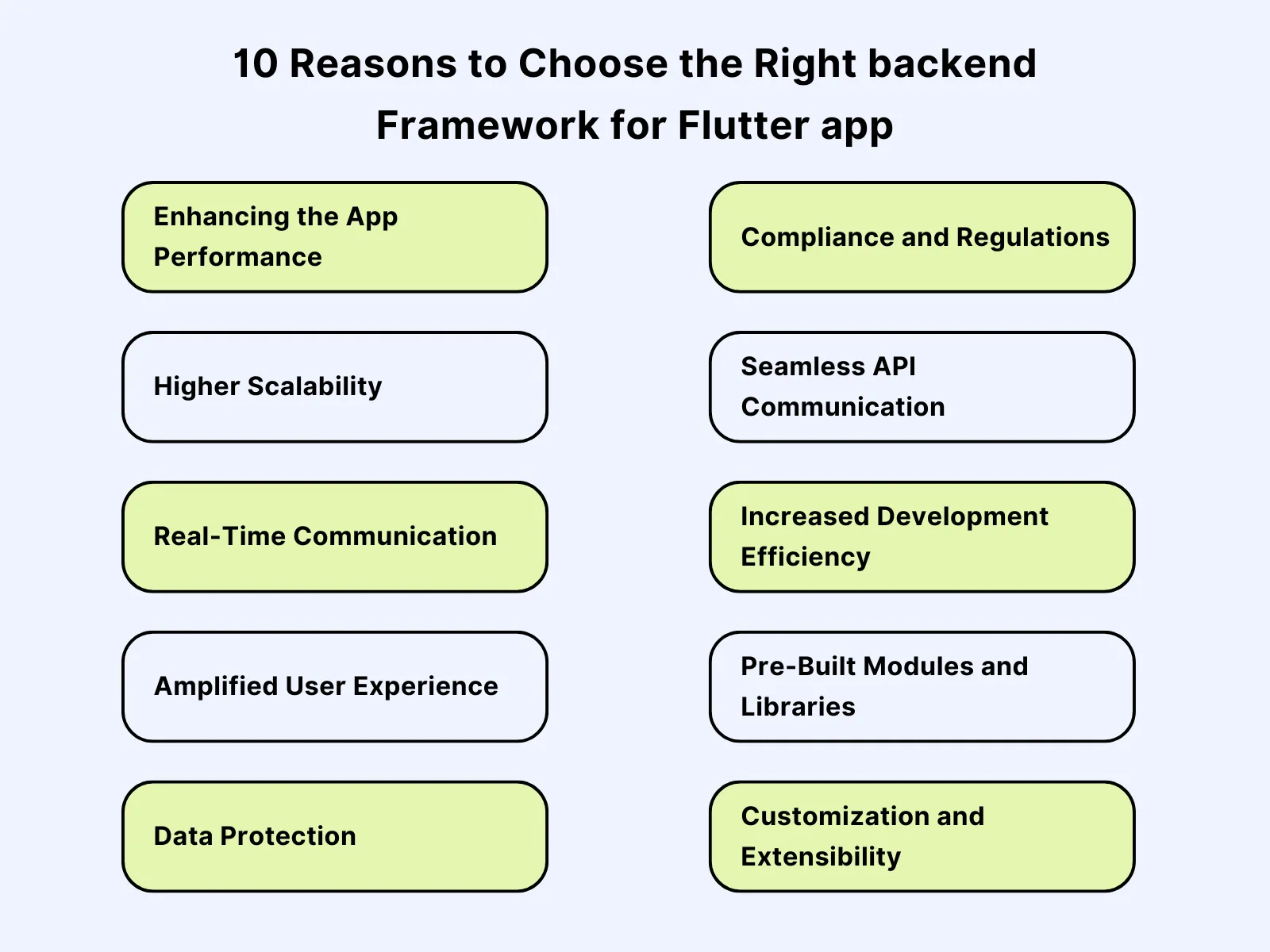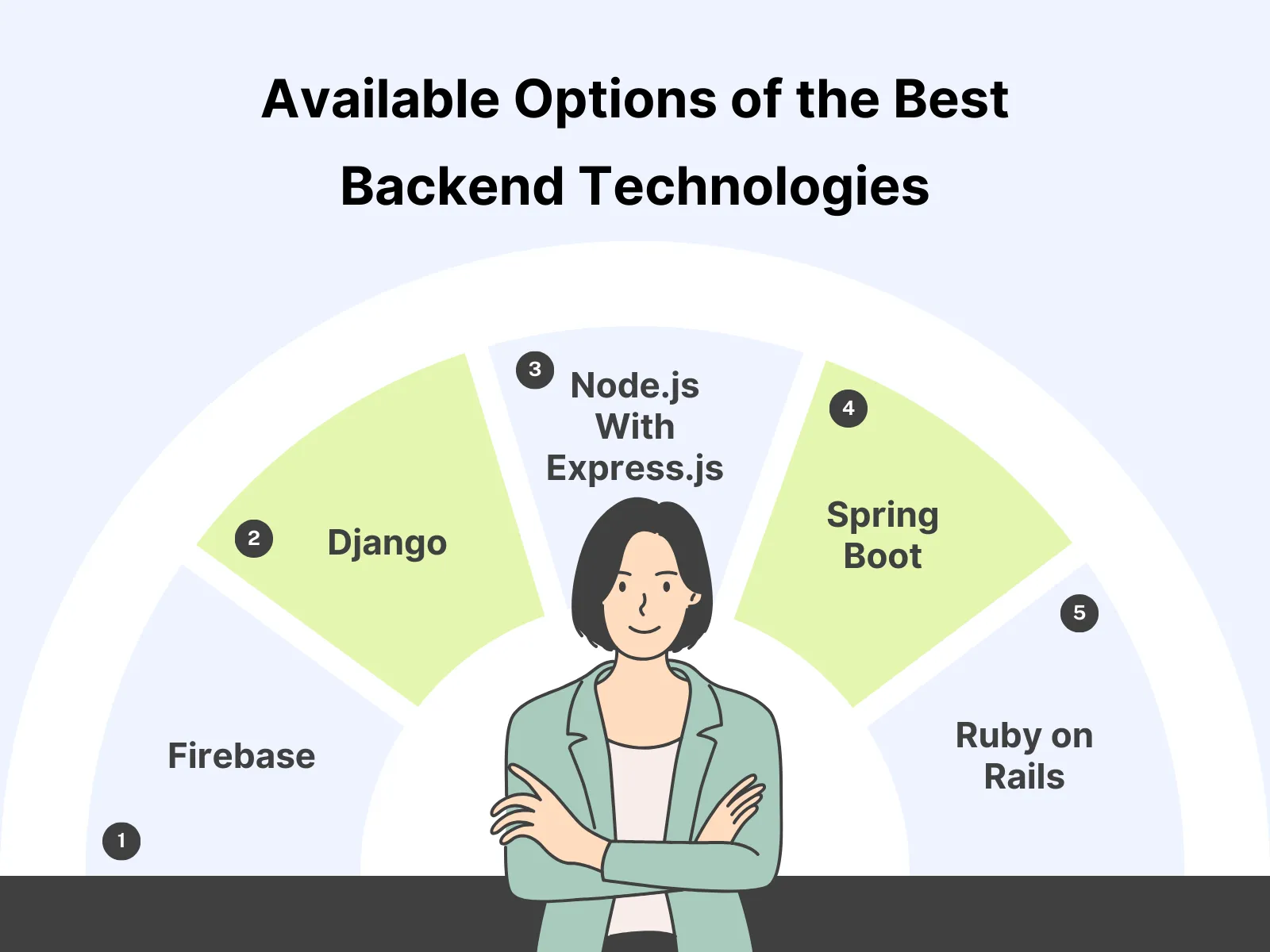Choosing the Right Backend Framework for Flutter Apps: Performance, Scalability, and Security
The selection of the right backend framework for the Flutter application development ensures enhanced scalability, improved performance, and seamless integration, including augmented user experiences.

Introduction
Flutter is a free and open-source UI software development kit developed and maintained by Google. Software Development Kit or SDK is the backbone of mobile and web platforms, allowing developers to create feature-rich, highly functional, and complex applications efficiently.
This framework can be used to create cross-platform applications for web, mobile, and desktop using a single codebase, providing a native look and feel for Android and iOS applications.
The backend of the Flutter app development communicates with server-side functionalities and logic using the Backend-as-a-Service (BaaS) cloud computing model. BaaS also plays an imperative role in handling APIs and services, and database management. The core technologies utilized are Node.js, Django, Ruby on Rails, and Firebase.
As a leading and premier Flutter App Development Company, we at TRooTech found that organizations of all sizes and types prioritize Google’s SDK over others for mobile application development services.
However, most of our clients have a common question, ‘What is the best backend technology stack that can power the server side of my application, improving its performance, and scalability, and offering robust security’?
We answer their question by helping them choose the ideal backend technology stack based on their unique project requirements and business goals.
If you also wish to know the answer to this same question, read this full article till the end where you will get familiar with
- Understanding the Role of Backend Technologies in Flutter Apps
- Vital Factors to Consider Before Selecting a Backend Technology
- The Wide Range of Backend Technology Options
- Considerations for Implementation of Backend Technology
- Future Trends and Technologies
Why is it Essential to Choose the Right Server-Side Technology Stack for Flutter Applications

Enhancing the App Performance - The backend technologies determine the speed and efficiency of the app to process requests, retrieve data, and respond to requests. Technologies with high concurrency and effective data resource management ensure the app’s enhanced performance even under heavy load.
Higher Scalability - The backend technologies must be able to accommodate increased users of the application. This is achieved through higher scalability with horizontal (adding more servers) and vertical (enhancing server capabilities) scaling to manage more traffic without impacting the app performance.
Real-Time Communication - Mobile and web applications with instant messaging platforms, live tracking, and collaboration facilities need instant data updates. Backend tech stacks with real-time capabilities, including Node.js and Firebase, offer WebSockets and infrastructure to integrate push notifications, live feeds, and synchronous data exchange..
Amplified User Experience - Backend technologies manage real-time data, ensuring users receive instant updates to improve engagement and satisfaction. This is critical for applications where timely information is paramount.
Data Protection - Flutter app development companies hire backend developers to ensure that server-side solutions safeguard sensitive information through data encryption, user access control, authentication mechanisms, and regular app updates. Server-side technologies offer robust security features to protect data breaches and ensure user trust.
Compliance and Regulations - Choosing the right backend technology is also pivotal in complying with mandatory regulatory requirements, such as GDPR, HL7, HIPPA, and CCPA, based on the application category. The right backend stack offers tools and practices to help meet these legal requirements.
Seamless API Communication - A seamless backend integration paves the way for smoother communication with the front-end using well-defined APIs. Seamless API communication is essential to integrate functionalities like user authentication, data synchronization, and third-party services.
Increased Development Efficiency - Seamless integration also helps to accelerate development time, minimize complexity, and let developers focus on building features rather than troubleshooting connectivity issues.
Pre-Built Modules and Libraries - Some backend technologies like Node.js and Ruby on Rails provide extensive libraries, tools, and frameworks that streamline app development. They also make it easier for developers to implement features like user management, payment processing, and data analytics.
Customization and Extensibility - A flexible backend stack allows developers to tailor the backend to specific needs, add custom features, and integrate with various third-party services. This adaptability is vital for creating unique and feature-rich applications.
Unleash the Benefits of Backend Technologies for Flutter Apps to Gain Competitive Edge
Explore the Wide Options of Backend Tech Stacks for Your Project
Diverse Industry Domains That Flutter Application Caters to
Flutter is known for its versatility, offering a powerful open-source UI toolkit to create natively compiled applications and catering to diverse industry verticals including
1. eCommerce and Retail
Renowned eCommerce platforms like eBay Motors and Estay use Flutter due to its user-friendly interface and customer-centric features that provide a streamlined shopping experience with seamless payment processing, order tracking, simplified product search, and personalized recommendations. This is why businesses looking for eCommerce software development prefer Flutter over others.
2. Finance and Banking
The finance and banking industry harnesses the Flutter app development services to build highly secure and reliable applications to safeguard online banking and transactions, protect investment and insurance sensitive data, and personalize financial management.
3. Healthcare
The Flutter software development kit, enhanced by backend technologies, has streamlined healthcare software development by automating tasks such as appointment scheduling, patient registration, billing, invoicing, and patient record management. Its scalability and flexibility enable healthcare providers to offer comprehensive digital health solutions.
4. Education and eLearning
Flutter plays an instrumental role in developing interactive and user-intuitive e-learning platforms with user-centric features like online courses, virtual classrooms, quizzes, and progress tracking. You can choose this cross-platform education software development service to ensure simplified content delivery and accessibility, enhancing the learning experience for students and tutors alike.
5. Media and Entertainment
For businesses serving the media and entertainment industry, Flutter can streamline the services for news portals and social media platforms. They can hire Flutter app developers to craft high-quality graphics and animations, ensuring a captivating experience for retaining users.
6. Real Estate
If you are serving the real estate industry, Flutter can assist you in simplifying the property search process with feature-rich capabilities like virtual tours and streamlining client-agent communication. The framework can integrate with various APIs and services allowing for comprehensive and user-friendly real estate solutions.
Besides these, companies catering to travel, hospitality, logistics, and transportation can also consult Flutter app development companies to increase their user base and optimize operations.
Plan to Implement and Use Django For eCommerce Development?
Learn About its Benefits for Large-Scale eCommerce Projects
Factors to Consider When Choosing Backend Technology
We have discussed previously how powerful backend technologies empower Flutter applications. Primarily, the server-side tech stacks focus on three critical areas.
- Enhancing Application Performance
- Amplifying the Application Scalability
- Fortifying the Application Security
Enhancing the App Performance - A strong back means that your application can process data speedily and accelerate the response times to augment user experience.
For example, you can utilize Firebase as a backend technology to increase application performance by offering real-time database functionalities and robust cloud computing features ensuring minimal latency and seamless interaction.
Amplifying the Application Scalability - There is no denying that with time your application’s user base will increase and you require an efficient and robust database to cater to and accommodate the traffic growth and data volume. The backend development technologies get comprehensive support from cloud computing solutions like AWS, Azure, and GCP, providing scalable infrastructure, and allowing your app to handle millions of users without performance hiccups.
Here, we can cite the example of the eCommerce giant Alibaba.com using a scalable backend to manage peak traffic and sales volumes, ensuring a consistent user experience.
Fortifying the Application Security - It is crucial to note that backend technology stacks are largely responsible for maintaining and fortifying application security to protect user-sensitive data against cyber attacks and breaches. Hence, you must implement robust security measures using Flutter’s backend capabilities like data encryption, multi-factor authentication, user access control, and regular security updates.
Let’s take the example of banking applications where backend integration with advanced security protocols like OAuth2 and two-factor authentication can protect user accounts from unauthorized access and fraud.
Aligning Backend Technology with Specific Industry Requirements
In this section, we will highlight how different backend technologies align with specific industry and business goals, enabling organizations to reap the benefits.
Let’s take the first example of healthcare applications. Suppose, you are planning to build an EMR application or a telemedicine application. You are aware that these apps must comply with HIPPA and HL7 regulations.
However, when it comes to securing the backend requirements, the Flutter app development company must focus on protecting data storage, encryption, and user authentication to protect patient information.
Similarly, let’s take another example of eCommerce applications. An eCommerce application or an online retail store must build a robust backend to seamlessly handle large traffic during special promotional events or discount periods.
Here, top Flutter app development companies like TRooTech provide scalable and efficient cloud computing solutions, such as AWS and Azure to ensure consistent performance under load.
Collaborating Backend Development Technologies With Business Objectives
The core aim of aligning the backend tech stack with your specific business objectives is accelerating growth, bringing cost-efficiency, and enhancing overall user experience.
We can discuss them in brief.
Suppose, for example, any startup business is launching a social media platform. In that case, it can select a backend framework like Firebase to facilitate quick development and market entry.
Features like pre-built modules, easy integration, and real-time database capabilities will help achieve the goal.
Now, if a small business wants to gain cost efficiency and reduce operational costs. It can choose open-source solutions like Django or Ruby on Rails that provide extensive libraries and community support, reducing development costs.
Similarly, businesses that want to augment customer experiences and improve user retention can opt for Node.js, offering a robust and secure backend with features like OAuth2 authentication, ensuring user trust and satisfaction.
Empower Your eCommerce Platform with Django for Maximum Efficiency
Streamline Your Online Business with Django
Exploring the Available Options of the Best Backend Technologies

So far we have discussed the role of backend development technologies in Flutter applications and the essential factors to consider when choosing server-side tech stacks.
Now, we are going to explore the various available backend technologies that Flutter app development companies can consider based on specific roles, project requirements, and business objectives. Let’s start with Firebase first.
1. Firebase :
Firebase is an excellent backend solution option for Flutter app development as it offers real-time authentication, database, and cloud-powered functionalities. The real-time database enables Flutter developers to sync data instantly across all services, making it a perfect choice for applications that require live updates, such as GPS, chat, social media, and collaboration tools.
Core Features:
- Firebase provides robust authentication services to streamline user management with secure and customizable methods like email, password, social media accounts, and more.
- Cloud computing and infrastructure solutions in Firebase offer serverless computing, allowing developers to run backend code in response to events triggered by Firebase features and HTTPS requests.
- It also ensures seamless integration and scalability to minimize server overhead management.
- Industries like eCommerce, banking, healthcare, etc. that provide real-time analytics leverages Firebase to access rapid development and deployment, while maintaining high performance.
2. Django :
Django is a popular and powerful backend framework powered by Python that can create scalable and secure server-side applications. This backend tech is an ideal choice for building eCommerce and fintech applications. We have already written a detailed article on why Django is the best choice for developing eCommerce platforms.
Core Features:
- Django simplifies database management and streamlines processes through its robust ORM and automatic admin interface functionality, accelerating the development process.
- The backend technology offers fortified security features like cross-site scripting, protection against SQL injection, and cross-site request forgery.
- Django is known for its high scalability, enabling it to manage increased traffic efficiently without impacting the application performance and data integrity.
- Django can also help create APIs for Flutter applications using the REST framework and offering a seamless backed integration that supports complex business logic and user interactions.
3. Node.js With Express.js:
Node.js is a renowned and widely used backend technology framework for developing Flutter applications. When it aligns with Express.js, the duo becomes the best pick for creating real-time apps with event-driven architecture. Businesses catering to industries like messaging, gaming, and IoT-based platforms can select Node.js with Express.js.
Core Features:
- Node.js can handle multiple connections simultaneously and efficiently due to its non-blocking I/O operations to reduce latency and ensure high performance.
- Express.js is a scalable and flexible Node.js web application framework that offers a diverse feature set and robust security for building web and mobile applications.
- Node.js and Express.js streamline the RESTful API development process and ensure its seamless integration with Flutter applications.
- The combination of Node.js and Express.js can manage asynchronous events efficiently and provides an extensive ecosystem of libraries and tools.
4. Spring Boot:
Are you looking to create an enterprise-grade Flutter application with robust functionalities and high-end security? If yes, then we recommend you choose Spring Boot as your backend framework. The simple and core reason for that is it supports large and complex business processes. Industries catering to finance, insurance, inventory, and supply chain management can opt for Spring Boot to power their server-side applications.
Core Features:
- Spring Boot prioritizes convention over configuration to lower the extensive boilerplate code requirement through production-ready applications.
- This widely used backend solution integrates with an extensive Spring ecosystem, letting the developers create scalable and secure microservices architecture and ensure optimal performance and reliability.
- Spring Boot provides robust security measures with complete authorization and authentication mechanisms, to manage sensitive data and transactions safely.
- The backend tech stack also supports different cloud platforms like AWS, Azure, and GCP, including data access technologies to develop resilient and flexible server-side services. Companies can look to hire Flutter developers to build applications that need robust business logic and enterprise-level integrations.
5. Ruby on Rails:
Ah! At last, we have brought some good news for small businesses and especially startups that are looking for an optimal backend technology stack to support their database and servers. Yes, Ruby on Rails is that backend and rapid development framework, ideally fit for industries like digital marketing, content management, retail, and more.
Core Features:
- Like Spring Boot, Rails also focuses more on convention than configuration offering extensive libraries with quicker development cycle capabilities and faster time-to-market.
- It also emphasizes RESTful architecture to build APIs that are used by Flutter applications.
- It can simplify database interactions using its built-in ActiveRecord and ORM.
- Ruby on Rails can manage complex business processes and logic, including user authentication efficiently to develop scalable and secure applications.
- This backend framework has a strong and rich ecosystem, offering additional features and support.
- It is a viable choice for Flutter app development services to build and iterate applications.
Matching Industries With Suitable Backend Technologies
Firebase is an ideal choice for eCommerce, health, and real-time applications.
Top eCommerce platform uses Firebase Alibaba.com to manage real-time data synchronization, providing a smooth shopping experience. Firebase also helps to handle inventory and customer interactions.
Django is the best fit for media and entertainment, social media platforms, content management
Renowned social media platform Instagram and popular video-sharing platform YouTube use Django to process large volumes of data and user interactions, including adding and updating features.
Node.js is the perfect backend solution for real-time applications and messaging platforms
Top-notch employment-focused social media platform LinkedIn uses Node.js to manage more than 500+ million users and enhance its performance and scalability. Similarly, Node.s allows Uber's cab booking app to process data efficiently for real-time messaging and increase scalability.
Spring Boot is the best fit for supply chain management, logistics, digital media, and eCommerce.
Leading popular OTT platform Netflix uses Spring Boot to enable efficient, scalable, and robust microservices architecture to handle massive amounts of streaming data and user interactions.
Ruby on Rails is ideal for content management, eCommerce, hospitality, etc.
Premier accommodation booking platform Airbnb uses Ruby on Rails to enhance the platform’s scalability, flexibility, and API integration capabilities.
Pivotal Strategies and Considerations to Implement and Maintain Backend Solutions

We have already discussed the role of backend technologies in enhancing the performance, scalability, and security of the Flutter applications. But do you know what core strategies and considerations you must consider to implement and maintain the server-side stacks? Let’s find out.
Strategies For Ensuring Scalability And Optimizing Performance
- You must add more servers for horizontal scaling and evenly distribute the workload efficiently.
- Implementing caching strategies helps to minimize the backend server loads and improve response times.
- Load balancing assists in distributing the incoming traffic evenly across multiple servers.
- Optimizing the database queries and indexes enhances performance and reduces latency.
- Regularly monitor system performance and conduct stress testing to identify bottlenecks and areas for improvement.
Best Practices For Implementing Robust Security Measures
- Implementing encryption measures like SSL/TLS helps to secure data transmission over networks.
- QA and software testing experts must integrate robust authorization and authentication mechanisms to control data access and functionalities.
- Make it a practice to update the software components and libraries regularly to patch unknown vulnerabilities.
- Conducting regular security audits and penetration testing helps to identify and address potential security flaws.
- Ensure compliance with relevant industry regulations such as GDPR, HIPAA, or PCI DSS by implementing appropriate security controls and protocols.
Considerations For Integration and Maintenance
- Create clear documentation and outline integration protocols to ensure seamless integration with current infrastructure.
- Identify issues and address them promptly by incorporating automated monitoring and alerting systems.
- Establish a regular maintenance schedule to apply updates, patches, and upgrades to the backend systems.
- Provide complete training to team members for maintaining and troubleshooting the system.
- Evaluate and upgrade the integration process continuously and keep adopting future trends and evolving technologies.
Future Trends in Backend Development Technologies Innovating Flutter
Several emerging trends and next-generation technologies in backend solutions are shaping the future of Flutter App Development. They are -
Serverless Architecture - Serverless architecture has become a trending choice for backend development technologies, allowing developers to write code without managing server infrastructure. Users only pay for actual usage, speeding up development and enabling faster app launches, saving time and costs.
Microservices Architecture - Microservices architecture breaks down applications into smaller, independent services, facilitating easier development, scaling, and deployment. Tools like Kubernetes and distributed databases enhance update speed and operational efficiency.
Containerization and Orchestration - Backend tech stacks for Flutter apps leverage containerization and orchestration tools like Kubernetes and Docker to manage and run microservices efficiently. This ensures consistent resource utilization across production environments.
Backend as a Service - BaaS is a cloud-powered model where organizations outsource backend development to external providers. It offers services like database management, push notifications, and server authentication through pre-written software components, streamlining development and reducing maintenance overhead.
Zero Trust Architecture - We had earlier talked about implementing robust security measures in the backend development technology. As a step beyond traditional security measures, organizations are adopting zero-trust architecture. This approach requires continuous user and device authentication, limiting access to sensitive data, and enhancing overall security posture.
Conclusion
After a thorough understanding, analysis, and discussion we can conclude that selecting the right and appropriate backend technology stack for Flutter applications includes careful consideration of performance, scalability, security, maintenance, and integration.
Organizations can hire Flutter developers to access their specific business requirements and scalability needs. They must prioritize implementing robust security measures by choosing the right server-side framework and evaluating its compatibility with front-end tech stacks.
At the same time, businesses must keep an eye on the latest backend technologies and Flutter development trends to maximize the long-term benefits and success of Flutter apps.
FAQs
he backend technology in a Flutter application utilizes GraphQL and RESTful APIs for communication between the application and the server. Server-side technologies are implemented using frameworks such as Firebase, Node.js, Django, Ruby on Rails, among others. These frameworks facilitate backend logic and functionalities. Additionally, databases like MySQL or MongoDB are commonly used for storing and managing data.
Backend technologies in Flutter applications are essential for managing data processing, retrieval, and storage. They provide robust APIs for seamless communication, handle user authentication, ensure data security, and facilitate real-time app updates. These functionalities enable Flutter front-end developers to deliver a smooth and responsive user experience, leveraging structured data and critical business logic.
The best backend technology options available are Firebase, Node.js with Express.js, Django, Spring Boot, and Ruby on Rails. Apart from these, backend developers can also choose Python, Golang, and Java server-side frameworks for Flutter applications.
Implementing backend technologies in Flutter apps involves challenges like ensuring seamless API integration, managing state and data synchronization, handling authentication securely, and optimizing performance for real-time updates. Additionally, developers must address cross-platform compatibility, error handling, and scalability to maintain a robust and responsive application.
When it comes to choosing the best company for implementing backend technologies for Flutter applications, you may get multiple options to explore on search engine sites. However, TRooTech is a leading and established backend solution provider with a pool of experienced Python, Node.js, Django, Spring Boot, and Ruby on Rails developers.

